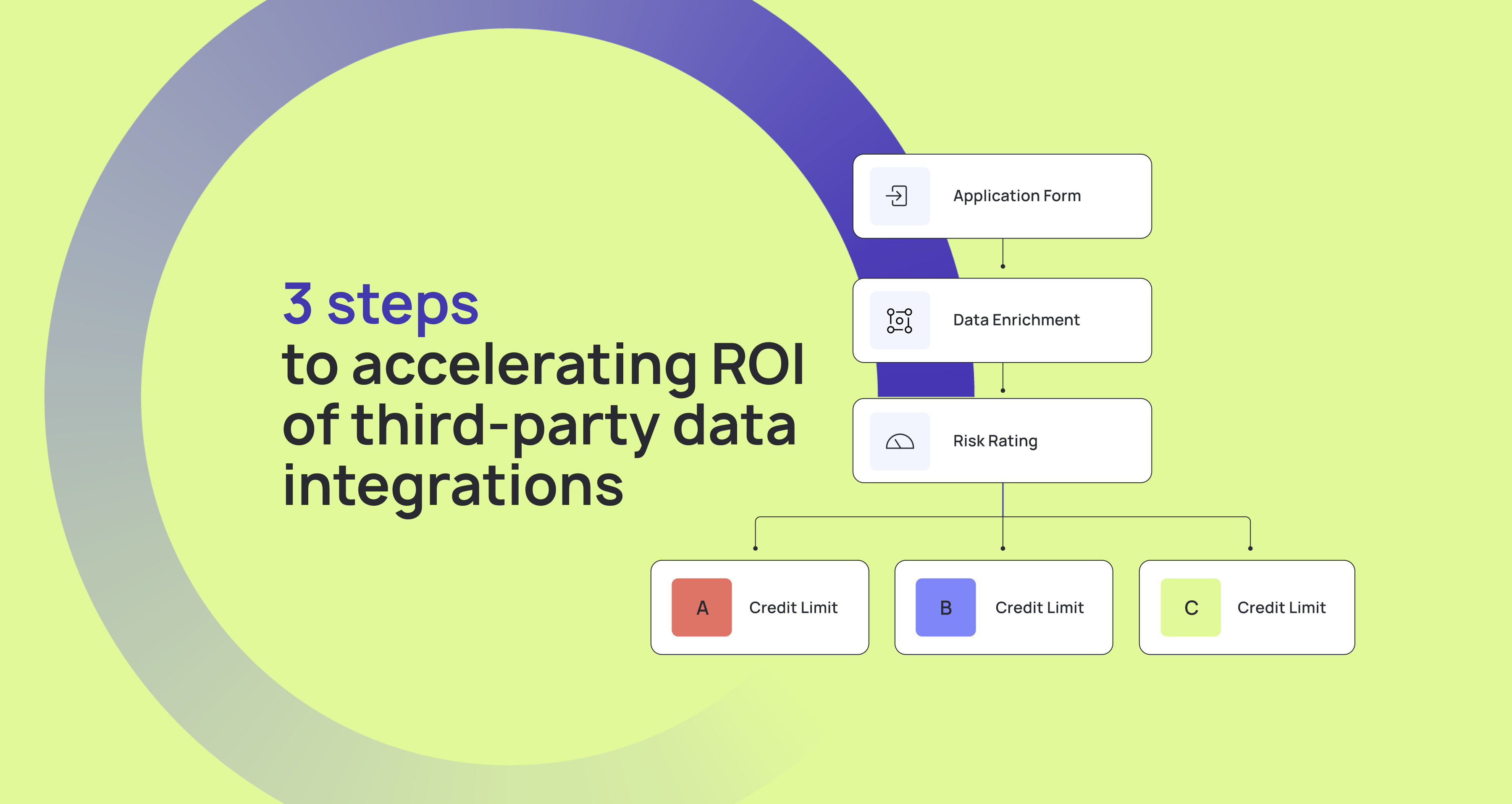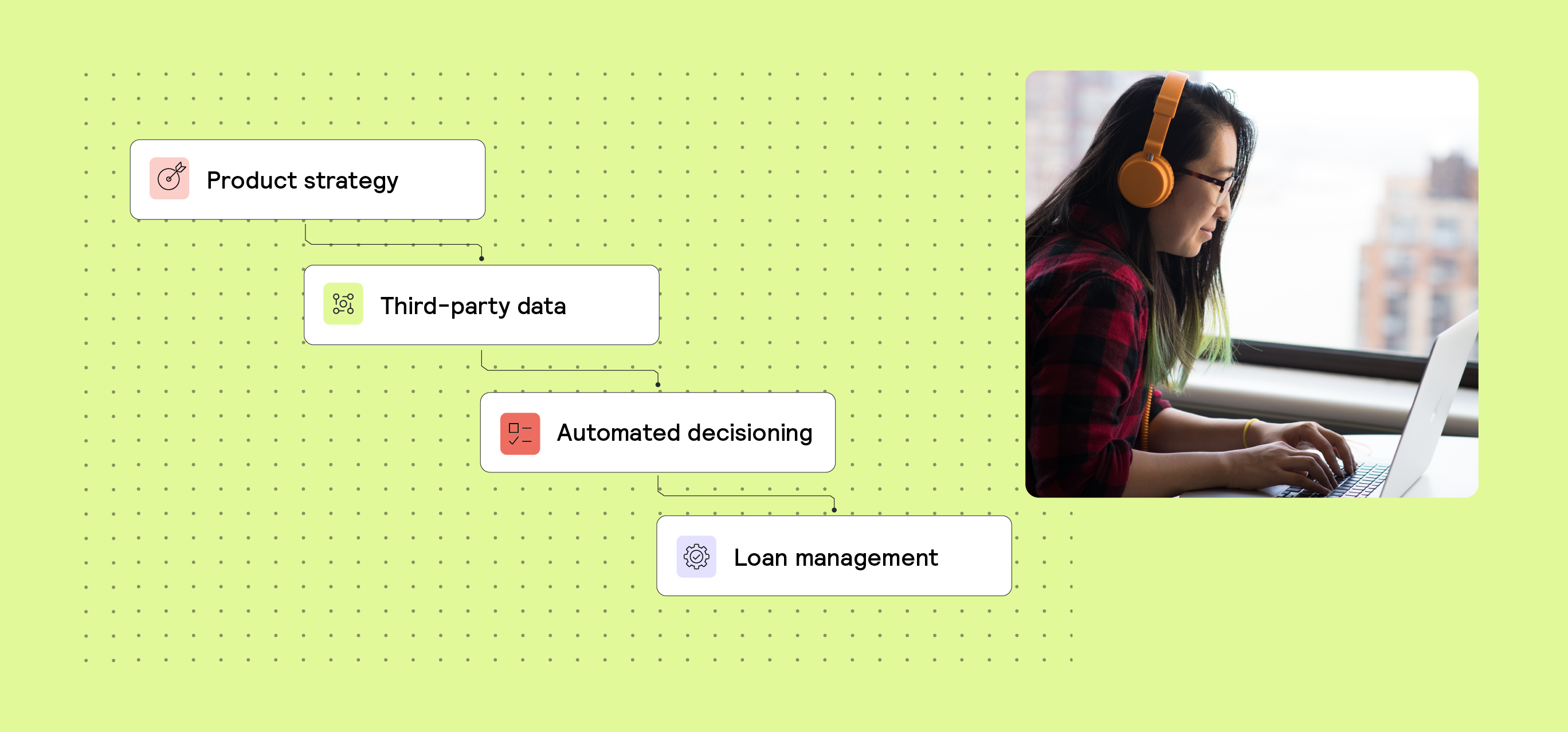Data, Fraud, Lending 4 min read
How to accelerate your ROI when integrating new third-party data sources

The combination of proprietary and third-party data has become a powerful competitive differentiator for teams building and managing financial products. However, transforming third-party data into actionable insights—insights that drive smarter risk management and product innovation—is a complex and resource-intensive process when undertaken in-house.
In this overview, we explore how teams can unlock the value of third-party data faster, featuring insights from Taktile and industry experts.
Key takeaways
- Streamline provider discovery: Access to a high-quality marketplace of third-party data providers allows for faster assessment of the data ecosystem, accelerating the evaluation and selection process.
- Leverage pre-built third-party connections: Pre-built integrations to preferred vendors, complete with caching, error handling, and retry functionalities, significantly speed up contracting and the technical integration process.
- Undertake rapid testing & optimization: Continuous testing and flexible KPI development capabilities enable faster, more direct business value generation.
Step 1: Discovery—Quickly uncover the best providers and streamline selection
The first step to unlocking value from third-party data is identifying providers that best align with your customer base and business goals. But whether focused on launching or enhancing customer onboarding, credit scoring, or fraud prevention, teams frequently encounter significant challenges during this phase.
The process of researching, comparing, and testing multiple providers is time-consuming and can quickly become overwhelming—especially in areas like fraud prevention, where new solution providers are constantly emerging. As a Credit Acceptance Expert in European banking notes,
“In almost every use case, but especially in the fraud space, new providers are constantly emerging. Looking for third-party solutions online feels like endlessly swiping on a dating app—there’s a new potential match appearing every day.”
This underscores the need for a streamlined approach to provider evaluation. By leveraging a high-quality marketplace of integrations with leading third-party providers, teams can accelerate discovery and gain confidence in their selection.
With a centralized hub to identify and compare the most suitable data sources, teams can work with greater clarity and efficiency, establishing a solid foundation for successful implementation.
Step 2: Implementation— Leverage pre-built provider connections to accelerate contracting and technical integration
Once the right data providers have been selected, the next crucial step is implementation. This phase involves formalizing provider partnerships through contract negotiations, establishing technical connections, and meeting all compliance and security requirements.
Each of these tasks requires careful coordination, as delays in one area can slow down the entire process. With multiple stakeholders and lengthy approval processes, implementation can be especially resource-intensive for both engineering and business teams.
Common challenges in this phase include extended contracting periods, complex security audits, and the technical work needed to build and test integrations.
As Frederik Vanhevel, VP of Engineering at Seen, explains,
“Integrating a new data source may seem straightforward at first—just call the API and process the response—but it's rarely that simple. Third-party data often brings unexpected complexity, especially when dealing with the vendor's unique response formats. These intricate formatting requirements can quickly consume countless engineering hours.”
For product and risk teams, an implementation process that minimizes engineering involvement is essential to minimize resource drain and allow teams to get new insights operational quickly.
Software providers that offer pre-built connections to third-party providers with built-in caching, error handling, and retries can significantly expedite this process, reducing implementation time from weeks or months to hours.
By minimizing technical and compliance overhead, teams can onboard providers swiftly, ensuring that data flows seamlessly into existing decision-making processes and keeps projects on schedule.
Step 3: Optimization—Rapidly integrate and experiment with new insights
The final step, optimization, is where the true value of third-party data is realized. This phase requires developing KPIs, refining insights, and tailoring data attributes to meet specific decision-making needs.
However, integrating third-party data into existing rules and risk policy logic comes with challenges: teams must convert raw data into actionable insights that align with their risk strategies and unique customer profiles. This often demands significant resources to define relevant KPIs, adjust data thresholds, and handle edge cases accurately.
Teams also face ongoing costs and trade-offs in continuously fine-tuning data inputs. Without efficient testing and iteration capabilities, decision-making can slow, affecting responsiveness to market changes.
To address these challenges, teams need infrastructure and capabilities that support rapid, iterative testing and flexible KPI development, allowing them to enhance data accuracy and quickly integrate new third-party insights.
As Maik Taro Wehmeyer, Co-Founder and CEO of Taktile, emphasizes,
“Decision platforms like Taktile are speeding up this process, giving teams faster access to new data sources and the ability to experiment and adjust strategies quickly. The rise of generative AI is further enhancing this, enabling faster, more precise analysis of large, unstructured datasets.”
Fintechs that excel at transforming raw third-party data into actionable insights position themselves to make faster, more confident decisions, fueling sustainable growth and a competitive edge in a data-driven world.
For a deeper dive into each phase of this overview, download our comprehensive guide: Rebalancing Risk & Reward: The Ultimate Guide to Leveraging Third-Party Data in Fintech Decisions.
Frequently Asked Questions (FAQs)
Q: How can financial institutions accelerate ROI when using third-party data sources?
A: By leveraging a marketplace of pre-built third-party data providers, institutions can shorten the discovery and integration process, quickly turning raw data into actionable insights for credit scoring, fraud prevention, and customer onboarding.
Q: What are the biggest challenges with third-party data integration in financial services?
A: Common hurdles include lengthy contracting cycles, complex compliance requirements, and technical integration delays. Pre-built connections with built-in error handling and caching help teams bypass these roadblocks and achieve faster time-to-value.
Q: Why is continuous optimization important after integrating a new third-party data source?
A: Ongoing optimization ensures that data isn’t just ingested, but actively improves decision-making over time. Through rapid KPI development and iterative testing, teams can refine risk models, adapt to market changes, and maximize business impact of new integrations.
Q: How do decision platforms improve third-party data ROI?
A: Modern decision platforms such as Taktile, feature pre-built thid-party data integrations, enable real-time testing, and in-platform analytics. This allows financial institutions to experiment, adapt strategies, and continuously unlock new value from both proprietary and external data sources – on one platform.
Q: What types of use cases in financial services benefit most from third-party data?
A: Use cases like fraud detection, credit decisioning, and customer onboarding see the fastest ROI, since enriched third-party data improves accuracy, reduces risk, and enhances user experience. Request a demo to see how Taktile can help you streamline this process.






